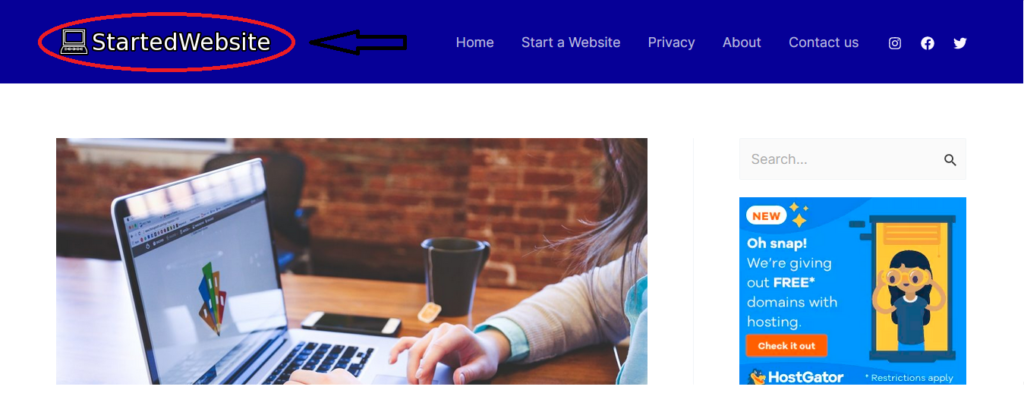Venturing into the online world can be an exhilarating experience, especially when you’re equipped to improve it at every turn. The key to a successful online presence is to Start a Website that stands out and truly represents your vision. It’s a proactive step towards showcasing your ideas, services, or products to a global audience with clarity and confidence.
The Importance of a Logo
A logo serves as the face of your brand, encapsulating your identity in a visual form that should resonate with your audience. It’s essential for creating a strong first impression, which can significantly influence a customer’s perception and their decision to engage with your brand. By integrating a logo into your brand strategy, you’re not just creating an image; you’re providing a point of recognition and a mark of quality that people can trust.
When you think about how to make a logo for my website, consider the logo’s role in crafting your brand’s identity. It’s more than just a graphic; it’s a symbol that carries the essence of your brand, your company’s values, and your promise to your customers. This visual cornerstone will appear on everything from your website to your business cards, making it a critical component of your marketing efforts.
The power of a well-designed logo lies in its ability to be remembered. A logo that stands out in the minds of your audience can significantly enhance brand recall. This means when they’re in need of your services or products, your brand is at the forefront of their thoughts, increasing the likelihood of them returning to your website.
Incorporating your logo into your overall brand strategy is a smart move. It ensures that your marketing materials are cohesive and that your brand message is consistent across all platforms. This consistency helps to reinforce your brand’s presence in the market and can help to build loyalty among your customer base.
Starting with a Concept
Defining your brand’s values and mission is the cornerstone of your logo creation process. It’s about distilling what you stand for and aim to achieve into a visual form that communicates this to your audience. Your logo should reflect these principles, giving a clear signal to customers about the nature of your business.
Getting to know your target audience is crucial. You need to grasp what appeals to them, their preferences, and expectations. This knowledge will shape the design elements of your logo, ensuring it resonates well with those you aim to serve.
Look around at the logos already out there, especially those within your field. They’re not just competitors; they’re a source of inspiration. Analyzing what works for them can spark ideas for how your logo can both fit within your industry and stand apart.
Choosing the Right Design Approach
Tackling logo design on your own can be a cost-effective option, and free online logo makers are a good place to start. They offer a range of templates and tools that can help you put together a basic logo. However, the downside is that your design may not be unique, and it might not capture the essence of your brand as effectively as a professional could.
Bringing a professional logo designer into the mix elevates the quality of your logo. They can provide expertise and a creative touch that’s tailored to your brand’s identity. With a professional, you can expect a more personalized service and a logo that stands out, but this will also mean a higher investment.
Logo design contests open the door to a variety of interpretations of your brand from different designers. This can give you a broad spectrum of ideas and styles to choose from. It’s a unique way to crowdsource creativity, but it can also be overwhelming to sift through the options and may involve a lot of back-and-forth communication.
Elements of a Great Logo Design
For a logo that will live on a website, clarity and simplicity are paramount. It needs to be easily identifiable at a glance, whether it’s nestled in a browser tab or displayed on a mobile screen. A simple logo translates well across various digital platforms, ensuring your brand is consistently recognized.
Designing for the long haul means your logo should withstand the test of time. It should sidestep the fleeting trends of digital design and anchor itself in the bedrock of classic aesthetics. This way, your logo remains relevant and strong as web design evolves.
Your logo’s adaptability is crucial in the digital space. It should look just as polished on a desktop browser as it does on a smartphone or as a favicon. This versatility ensures your brand’s logo maintains its effectiveness, no matter where it appears on the web.
Choosing colors and typography for your website’s logo also demands a strategic approach. Colors must be web-friendly and accessible, complementing the design of your site while standing out. The typography should be legible at various sizes, ensuring that your brand’s name is clear in every context on your site.
Refining Your Logo Design
Refining a logo is a process that often involves several iterations. You start with a concept, develop it into a design, and then tweak it. This cycle repeats, with each round sharpening and improving the logo until it perfectly represents your brand.
Feedback is a valuable part of refining your logo. It’s essential to show your design to people whose opinions you trust—potential customers, friends, or mentors. Their insights can highlight aspects you might not have considered and lead to improvements in the design.
Trademarking your logo is a vital step to protect your brand. It legally safeguards your logo from being used without your permission. This process involves checking that your logo isn’t similar to existing trademarks and then registering it to claim ownership.
Integrating Your Logo with Your Website

The placement and sizing of your logo on your website can significantly influence its impact. Ideally, it should be one of the first things visitors see without overwhelming the content. The top left corner is a common spot, as this is where eyes tend to go first, but the center can also be effective for certain website layouts.
Consistency in design across your website enhances the professional look and feel. Your logo’s color scheme, typography and style should be echoed throughout your site. This creates a cohesive experience for visitors and reinforces brand recognition.
Your logo should be adaptable for use beyond just your website. It needs to look good on social media profiles, in email signatures, and even on merchandise. Ensure your logo design is versatile enough to be resized or adjusted for these various platforms without losing its essence.
Finalizing and Implementing Your Logo
Settling on the final version of your logo is a significant step. It’s the emblem that will represent your brand across all online platforms. Reflect on your brand’s core values and ensure they are encapsulated in the design before making your decision.
Introducing your new logo to the world involves strategic planning. Update your website and all social media profiles, and consider timing the launch with a marketing campaign to maximize visibility. Informing your audience about the change helps maintain brand continuity and can even re-energize customer engagement.
Keep track of the response to your new logo once it’s out in the wild. Use tools to analyze engagement and sentiment around your brand. This ongoing evaluation can provide valuable feedback and highlight opportunities to refine your brand’s visual identity further.
Conclusion
Crafting the perfect logo for your website is a process that combines creativity with thoughtful planning. It’s about forging a symbol that encapsulates your brand’s core while connecting meaningfully with your audience and enduring through changing trends. Executed well, your logo becomes more than an identifier; it acts as a magnet that attracts visitors to your site, imprinting a durable image in their minds.
